|
|
 |
|
|
Fielding French Infantry in World War III
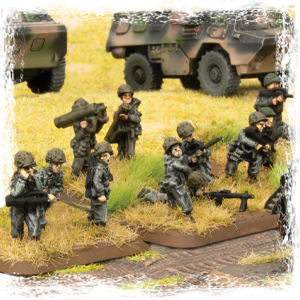 |
Fielding French Infantry in World War III
By The Little General
Many of you know me by my reputation as a French General and leader of combined arms forces. Although much has changed recently in today’s Armee De Terre (French Land Army), I have an intimate knowledge of what it takes to get the best out of mother France’s finest conscripts.
|
|
In your briefing for OTAN (Or NATO Forces for you Anglophone speakers), you hold the prize of France’s technological advances as well as its best-trained and most capable troops depicted. This is France, and the backbone of any army I would be proud of is its Infantry. Whether they be the descendants of the mighty Old Guard, the finest Voltigeur or even just a humble Chasseur, a French force can assure its general that they provide steady and efficient forces with excellent skill at arms. This fact has not changed for my Conscripts in over two hundred years and the French infantry can boast of the most efficient and well-armed troops you can expect to see on the battlefield.
|
|
It is a common myth that French victories were in short supply after the time of the Empire. Such folly would not be easily understood by those the French infantry and cavalry beat at battles such as Bir Hakiem in 1942 or Dompaire in 1944!
|
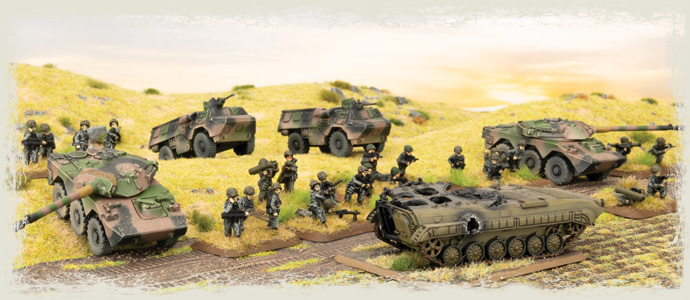 |
|
In World War III: Team Yankee, a French leader will find himself commanding a miniature army when commanding a Compagnie D’Infantiere. I would consider such a force to be the equal of any similar force in the world at this time, if not better.
|
| Let’s take a closer look, Capitaine, at your new command. I will use anglicised terms for the convenience of those who have yet to graduate from our fine academy at St Cyr. |
|
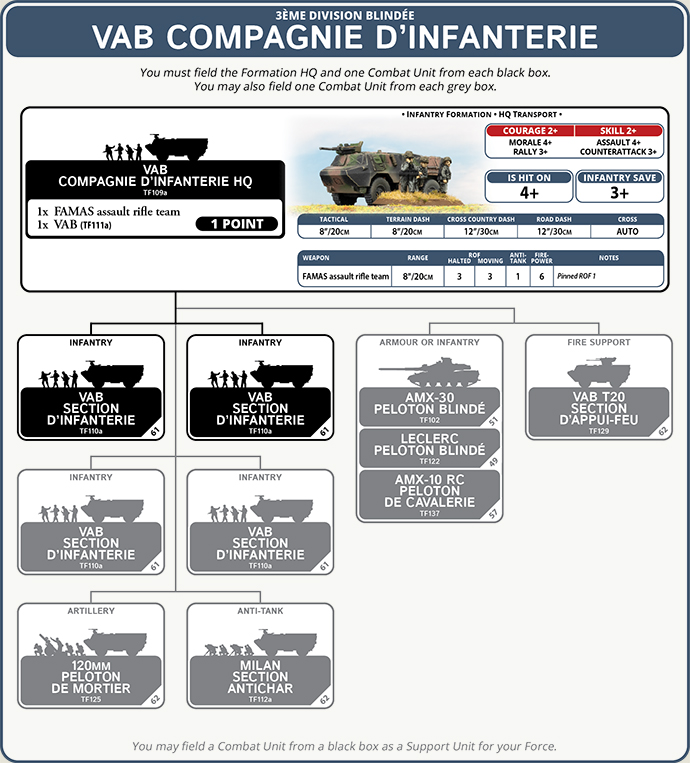
|
| Firstly. you have a command team which is your immediate leadership and their VAB APC. This is a humble yet efficient command vehicle that is amphibious and although wheeled, highly mobile and is the basis for all your transports below. |
|
Below this, you have at least two and up to four such Section D’Infanterie. These are the bread and butter of your army and are not to be discounted lightly by any enemy. With the right leadership, they can prove an immovable object with excellent equipment.
|
|
Each Section has at least five FAMAS fire teams and up to seven at full strength along with two LRAC launchers. Each individual FAMAS team has ROF 3 moving or 2 stationary with firepower 5+ thanks to rifle-fired grenades that also give them AT13 when needed. Truly excellent infantry.
|
|
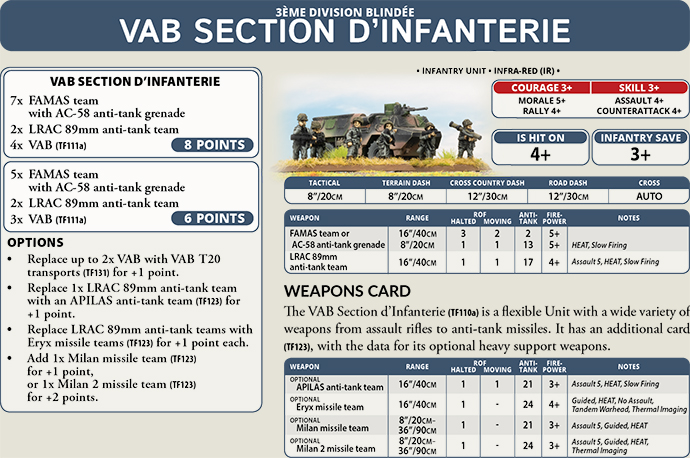
|
|
For anti-tank work, the Section is especially fortunate. Although the LRAC is a solid weapon at AT17 and 40cm/16” range, it is getting outdated. Fortunately, this can be supplemented with the LRACs replaced with one of each either for an APILAS or an ERYX team. These give an excellent ability for the cunning commander. APILAS being AT21, it will take care of any steel cavalry from the side – if not the front. Eryx is AT24 and has the same range, you can reconsider any foolish assaults of French infantry with these. The word means Boxer, so if you feel the need to unleash some close-range sledgehammering of your opponent, then Eryx is a hard tool to resist.
|
|
If you feel like your infantry need further reinforcing a Milan or Milan 2 can be added for a single point or two points for the latest version. With the same range, the Milan 2 is especially feared for being AT24 and supplements Eryx nicely at longer ranges.
|
| That is all well and good, Little General, but what if the enemy brings many of their vaunted tanks? How do we cope with limited numbers of anti-tank weapons having longer ranges? |
| Aha, a good point and one our beloved France has anticipated. |
| For this purpose, you have a professional unit that can stop any tank force. With up to eight Milan or Milan 2 missile specialists riding in up to four VAB APCs, you have sufficient firepower to blunt the enemy’s most potent thrust. I would highly recommend such support to your humble infantrymen. |
|
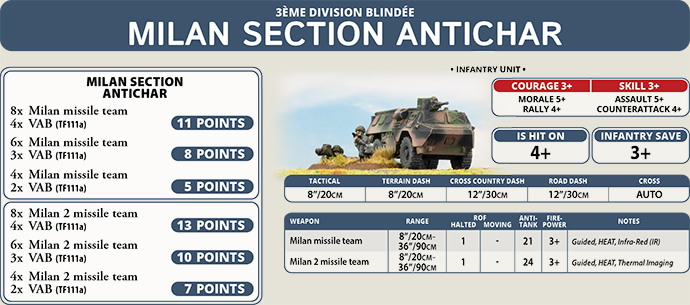
|
|
Of course, many of my colleagues aspire to the Marshall Ney school of shock action, preferring to have Cuirassiers on hand to protect the square against the toughest armour. In this, you are in luck Capitaine.
|
|
You may have a Troop of the toughest and most modern tanks in Europe here. Of course, the French Leclerc is just what you were hoping for. Excellent front armour of 22 coupled with incredible mobility of 35cm/14” tactical firing a main gun of Antitank 23 out to 120cm/48”? Mon Dieu, this is a tank to be proud of. Boasting up to four vehicles in a troop and having 2+ cross check and the usual 3+ skill of a Frenchman, such a unit will ‘Eryx’ above its weight. See what I did there, Capitaine?
|
|
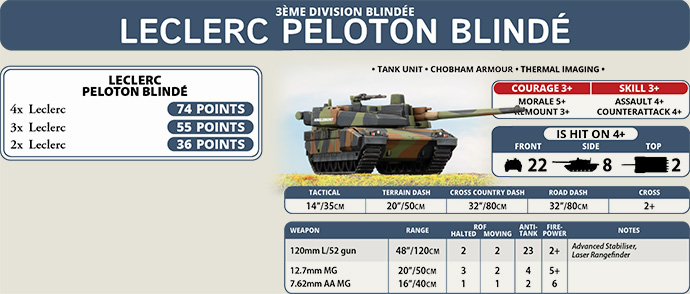
|
|
If you are a true romantic and want the backing of a tried and tested but lighter tank, the trusty AMX30 is available. Or if you feel you would like some reconnaissance and guidance on how to get to the battle more efficiently, no one has an armoured car as impressive as the AMX10RC available to the French in this option. Sadly you have to decide on one of these three most worthy of support options.
|
|
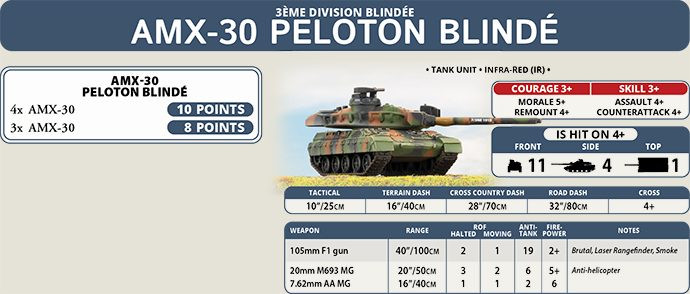
|
|
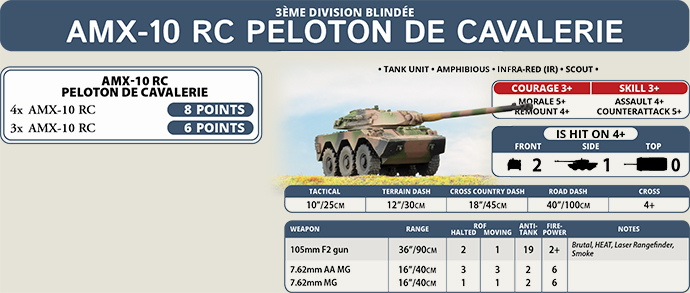
|
|
Of course, being a strong believer in combined arms as I am, I couldn’t pass up the opportunity to recommend my old favourite arm – artillery. Of course, we wouldn’t let our infantry go into battle without the closest of close support. You may have up to six towed mortars and VABs to deliver excellent supporting fires. Three is the minimum – if you really must share with other infantry – but six will deliver certainty with the rerolling of (unlikely) misses. A healthy range of Antitank 3+ and Firepower 3+ confirm the benefits of this most worthy successor of the battalion guns. Being able to reliably pin enemy infantry or provide that all-important smoke screen when needed OR to clear out enemy missile teams when you are moving up – the 120mm mortar teams will deliver as expected.
|
|
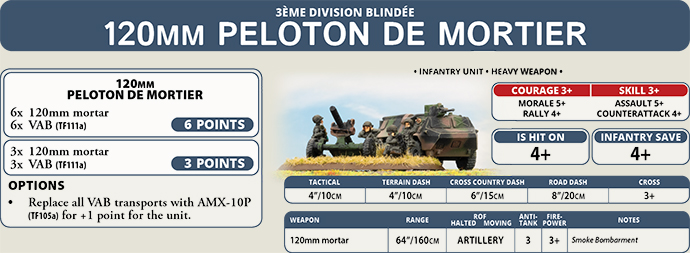
|
|
Lastly, France is not ignoring the threat of helicopters and light armour. The Army has recognised this threat and has provided a force of three to four VAB fire support vehicles with 20mm cannons that can also deal handily with helicopters or light armour and are the most affordable choice. You might even like to upgrade some regular VAB APCs into the T20 with the better gun, should you have sufficient Francs in the bank.
|
|
How would I configure this wealth of choices I hear you ask?
|
|
Because I only know one way to win and that is ATTACK, I won’t enfeeble your efforts with talk of holding down the enemy. A wise commander will take the fight to them. Of course, the French Infantry know how to attack from within their very bones.
|
|
My preference would be to have the following options if I were working on 100pts as our decimal system loves:
|
|
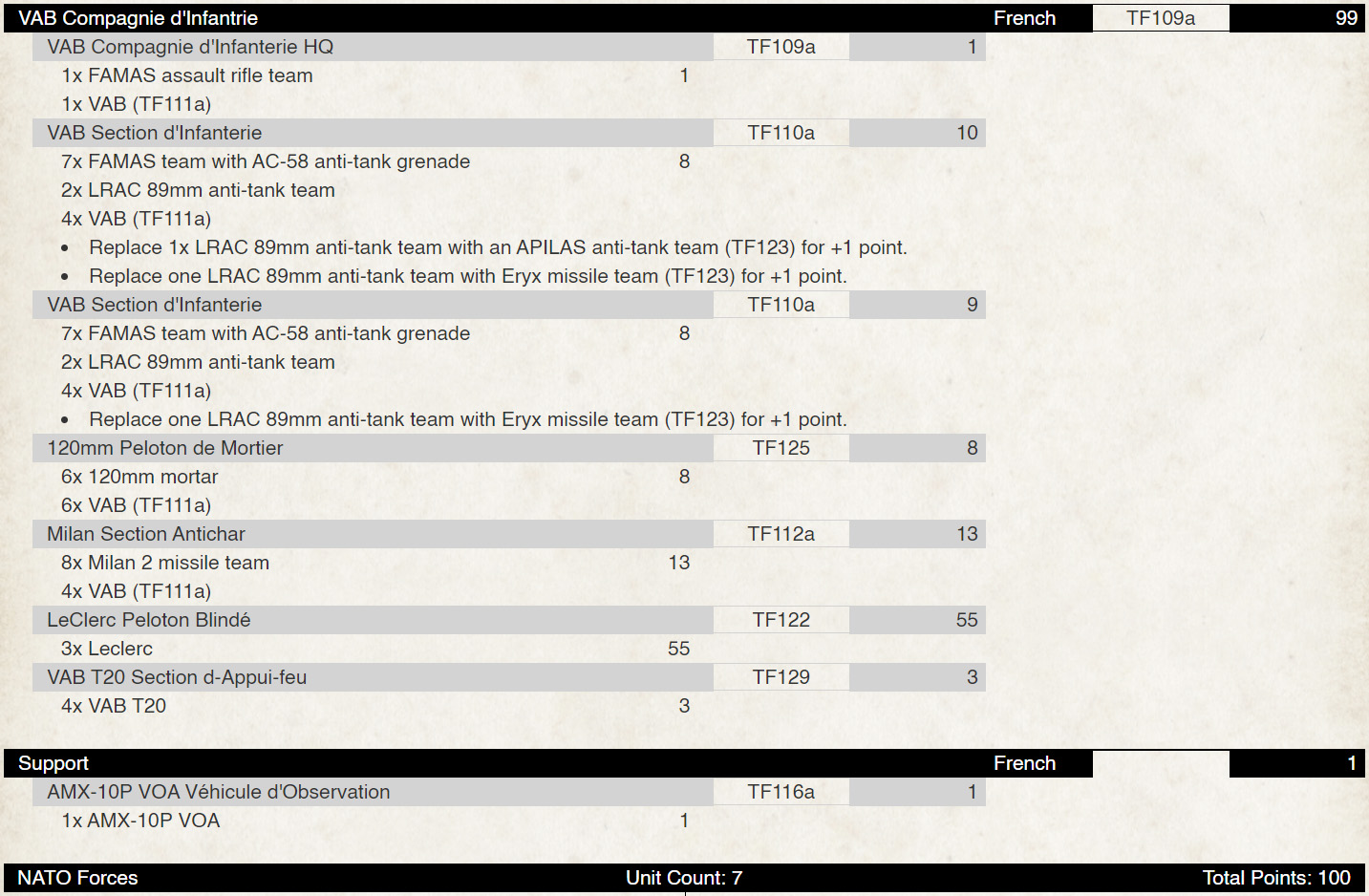
|
|
With the only exception being the Observer team, everything in your force is the one Capitaine’s command as a Company-sized unit. A powerful unit featuring three of the toughest tanks in the world, 27 stands of infantry and 10 AT 24 missile shots at various ranges. One could almost feel sorry for the Communists trying to push past these modern and brilliantly equipped and trained descendants of the Imperial Army. In my next briefing, I will provide some tactics and guidance for the young officer Cadet and explain how to make the most of your illustrious force.
|
|
~ The Little General
|
|
|
|